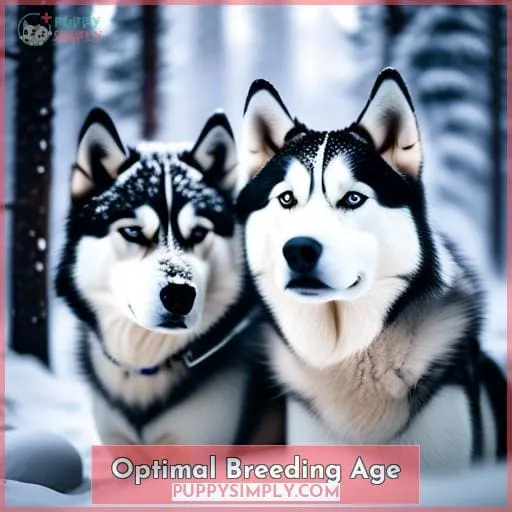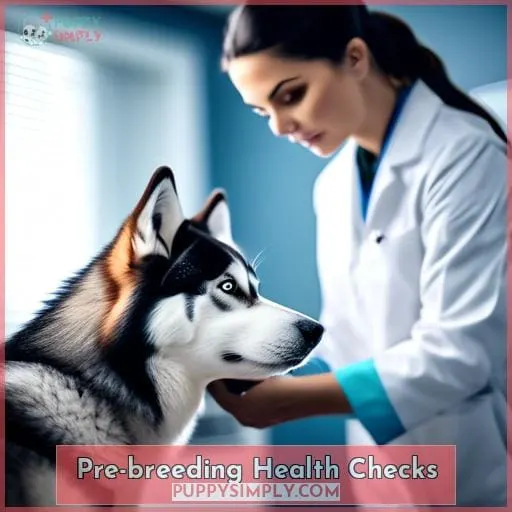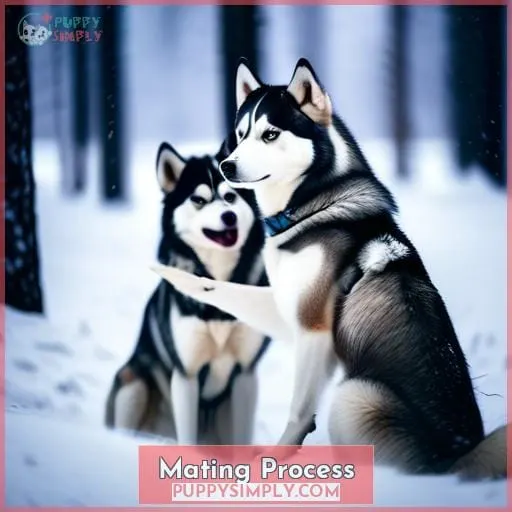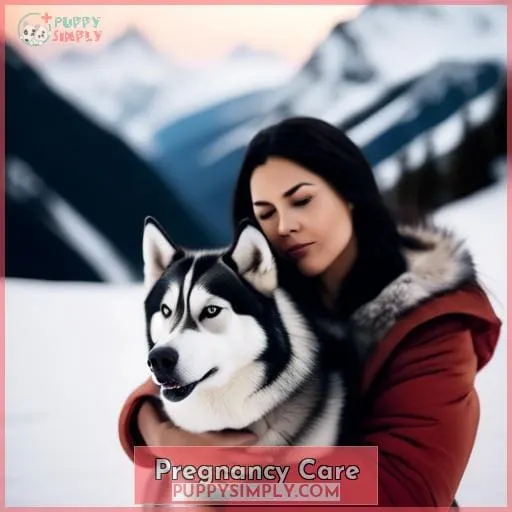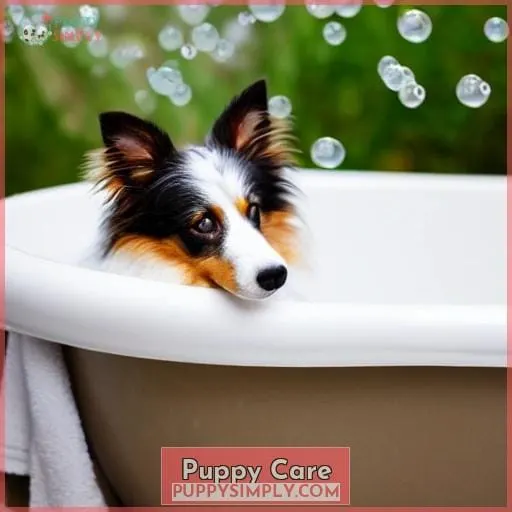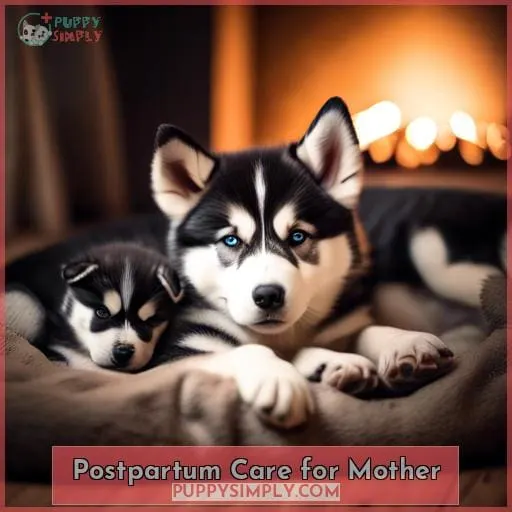This site is supported by our readers. We may earn a commission, at no cost to you, if you purchase through links.
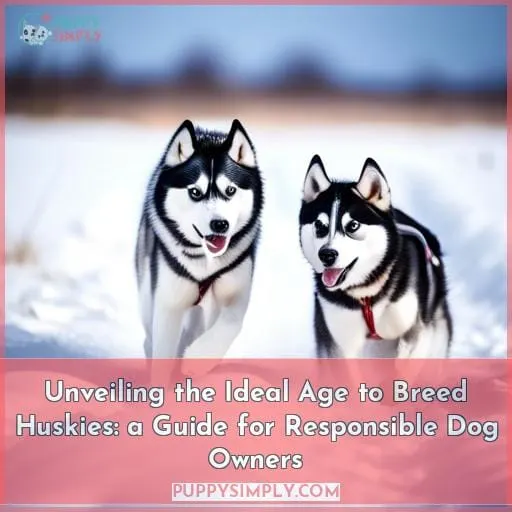
Discover the optimal age to embark on this journey, ensuring the well-being of both parents and puppies.
Gain insights into female heat cycles, pre-breeding health checks, and ethical considerations that shape successful breeding practices.
Delve into the intricacies of the mating process, pregnancy care, and whelping, equipping yourself with the knowledge to navigate each stage with confidence.
Learn how to provide exceptional care for the mother and her litter, ensuring the best start for your Husky puppies.
Table Of Contents
- Key Takeaways
- Understanding Female Heat Cycles
- Optimal Breeding Age
- Pre-breeding Health Checks
- Breeding Ethics
- Mating Process
- Pregnancy Care
- Whelping
- Puppy Care
- Postpartum Care for Mother
- Rehoming Puppies
- Frequently Asked Questions (FAQs)
- How do I prepare my husky for breeding before the ideal age?
- What are signs of pregnancy in a husky and what should I do to ensure a healthy pregnancy?
- Are there any potential complications during whelping and how can I prepare for them?
- What are the signs of labor in a husky and what steps should I take to assist with the birthing process?
- How can I ensure the puppies receive adequate nutrition and care during their early stages of development?
- Conclusion
Key Takeaways
- Optimal breeding age for both male and female Huskies is between 2 and 5 years old, maximizing chances of successful pregnancy and healthy puppies while reducing risks.
- Pre-breeding health checks, including genetic screenings and brucellosis tests, are essential to ensure the health of both the sire and dam before breeding.
- Responsible breeding practices prioritize health and temperament over appearance, avoiding overbreeding and selecting stud dogs carefully.
- Proper care during pregnancy, including dietary adjustments, preparation of a whelping box, and monitoring the mother’s temperature, is crucial for the well-being of the mother and her puppies.
Understanding Female Heat Cycles
As a responsible dog owner, you must understand the female heat cycle to determine the best time to breed your husky.
A female husky typically experiences her first heat between 6 and 12 months of age.
Her heat cycles will recur every 6 to 12 months thereafter.
Identifying the First Heat
During the first heat cycle, your female husky undergoes a transformation.
Her behavior shifts, and physical signs emerge, signaling her entry into puberty.
The age of this initial heat varies, influenced by genetics and environmental factors.
Hormonal changes trigger this cycle, which typically lasts for two to three weeks.
Understanding these heat cycles is crucial for responsible husky breeding, ensuring optimal timing and the well-being of your beloved companion.
Frequency of Heat Cycles
After experiencing her first heat, you can expect your female husky to go into heat every 6 to 12 months, with the average cycle lasting about 3 weeks.
This period is known as the estrus cycle, which consists of four stages:
- Proestrus
- Estrus
- Diestrus
- Anestrus
Understanding these stages is crucial for determining the optimal breeding window and ensuring successful mating.
Optimal Breeding Age
When it comes to breeding huskies, the optimal age for both females and males plays a crucial role in ensuring a successful and healthy breeding process.
As a responsible dog owner, understanding these optimal ages and adhering to them is essential for the well-being of your dogs and the quality of the puppies.
Optimal Age for Female Huskies:
- The ideal age for breeding female huskies is between 2 and 5 years old.
- During this period, they have reached physical and emotional maturity, ensuring a safer and more successful pregnancy.
Breeding females outside of this age range can increase the risk of complications during pregnancy and whelping.
Optimal Age for Male Huskies:
- Male huskies can start breeding as early as 12 months old, but the optimal age is between 2 and 5 years old.
- At this age, they have attained sexual maturity and are capable of producing healthy sperm.
Breeding males outside of this age range may result in lower sperm quality and reduced fertility.
Benefits of Adhering to Optimal Breeding Ages:
- Increased chances of a successful pregnancy and healthy puppies.
- Reduced risk of complications during pregnancy and whelping.
- Ensures the physical and emotional well-being of both the female and male huskies.
Maintains the genetic diversity and quality of the husky breed.
Conclusion:
Breeding huskies at the optimal age is a responsible practice that contributes to the health and well-being of the dogs and the quality of the puppies. By adhering to these optimal ages, dog owners can ensure a successful and ethical breeding process.
Female Maturity
You’ll need to wait until your female husky reaches two years of age, the recommended maturity level for breeding.
Early spaying can cause health issues, and natural mating at the right age ensures an optimal litter size.
Pre-breeding health tests and choosing a suitable mate are crucial for genetic diversity and healthy offspring.
Consequences of breeding too young include reproductive problems, birthing difficulties, and compromised puppy health.
Responsible breeding practices prioritize the well-being of both the mother and her puppies.
Male Maturity
While female huskies reach maturity sooner, male huskies take longer to fully mature, typically reaching breeding readiness between 18 and 24 months of age.
Stud dog selection is crucial to ensure sperm quality, temperament evaluation, and genetic diversity preservation.
Assess the male husky’s temperament, health, and genetic background to ensure suitability for breeding.
Negotiate breeding rights with the stud dog’s owner, considering factors like stud fees and puppy pick.
Pre-breeding Health Checks
Before breeding, you must ensure the health of both the sire and dam.
Perform genetic screenings to rule out breed-specific issues.
Test for brucellosis, a bacterial infection that can cause infertility and miscarriage.
Consult your veterinarian to determine the ideal timing for these tests.
Genetic Screening
Before breeding your Huskies, consider genetic screening to identify potential genetic defects or diseases that could be passed on to the puppies.
This proactive step helps ensure the progeny’s health and prevents inherited diseases from compromising the breed.
Pre-breeding health checks, including DNA testing, assess the compatibility of the breeding pair, minimizing the risks of genetic disorders.
Responsible breeding practices prioritize the well-being of future generations, preserving the breed’s integrity and avoiding complications that may arise from breeding dogs with undetected genetic issues.
Brucellosis Testing
Why is brucellosis testing crucial before breeding Huskies?
It’s a responsible breeding practice that prevents the spread of this bacterial disease, protecting the health of your Huskies and their puppies.
Brucellosis can cause reproductive problems, including infertility, spontaneous abortions, and weak offspring.
By testing both sire and dam before breeding, you can ensure that they’re free from this devastating disease, safeguarding the well-being of your breeding program and the future of your Husky lineage.
Breeding Ethics
As a responsible dog owner, you should prioritize breeding for health and temperament, not just appearance.
Overbreeding can lead to health issues and behavioral problems in puppies, so it’s crucial to breed your husky only when they’re at the optimal age and in good health.
Avoiding Overbreeding
Responsible breeding practices require you to avoid overbreeding your huskies to preserve their health.
Overbreeding can lead to genetic health risks in puppies and diminish the quality of your breeding stock.
As a responsible breeder, select a stud dog carefully, considering his age, health, and temperament.
Follow rules and regulations, and prioritize puppy socialization and care.
Breeding for Health, Not Just Appearance
As a responsible dog owner, you should prioritize breeding for the betterment of the husky breed, focusing on health and temperament over mere appearance.
Embrace the ethical breeding standards that put genetics versus appearance.
Implement health screening to rule out hereditary ailments.
Select suitable mates with complementary traits.
Encourage new owners to register their puppies with the AKC, upholding responsible breeding practices.
Mating Process
When it comes to mating, you’ll need to decide between natural breeding or artificial insemination.
Natural breeding involves the male mounting the female, resulting in a 10-30 minute tie.
Artificial insemination is an option if natural breeding isn’t practical, but proper procedures are key.
Natural Breeding
In natural breeding, you’ll want to introduce the male and female Huskies, allowing them to mate instinctively.
This involves the male mounting the female, resulting in a tie that can last for 10 to 30 minutes.
If natural breeding proves challenging, artificial insemination can be considered, but proper procedures must be followed.
DNA certification is required for AKC registration.
Artificial Insemination
Artificial insemination emerges as a viable alternative when natural breeding proves impractical, offering a controlled and precise method for uniting the sire and dam.
This technique involves collecting semen from a stud dog with superior genetic traits, ensuring optimal sperm quality and genetic diversity.
Artificial insemination empowers breeders to select stud dogs from distant locations, expanding the gene pool and minimizing the risk of inbreeding.
Pregnancy Care
As your husky’s pregnancy progresses, adjust her diet to meet her nutritional needs.
Ensure she receives ample calcium and protein.
Prepare a whelping box in a quiet, draft-free area.
Provide soft bedding and a heat source to keep the puppies warm after birth.
Nutrition for Pregnant Husky
- During pregnancy, gradually increase your Husky’s food intake to support her growing litter.
Provide high-quality puppy food or a nutritionally balanced diet supplemented with calcium and other essential nutrients.
Monitor her weight gain, aiming for a steady and moderate increase.
Consult your veterinarian for specific dietary recommendations and to address any concerns about common pregnancy complications like eclampsia or pregnancy toxemia.
Preparing for Whelping
Now that you’ve provided your pregnant husky with adequate nutrition, it’s time to prepare for the upcoming whelping.
Create a comfortable whelping box in a quiet, draft-free area, equipped with soft bedding and low sides for easy access.
Gather essential supplies like towels, a heating lamp, a thermometer, iodine, and a birthing kit.
Monitor the mother’s temperature closely, as a sudden drop signals the onset of labor.
Be prepared to assist with birth if necessary, but avoid interfering unless complications arise.
Once the puppies arrive, ensure they receive colostrum, the first milk containing vital antibodies, and keep them warm and clean.
Whelping
As your husky’s pregnancy nears its end, watch for signs of labor, like:
- Restlessness
- Panting
- Straining
When contractions begin, be ready to assist with the birth by:
- Removing placental membranes
- Cutting and tying the umbilical cord
Keep the newborn puppies warm and ensure they receive colostrum, their mother’s first milk, which is rich in essential antibodies.
Signs of Labor
As whelping nears, watch for signs of labor in your husky, including:
- Restlessness
- Panting
- Frequent trips to her whelping box
Her temperature will drop to around 98 degrees Fahrenheit within 24 hours of giving birth.
These signs indicate that the arrival of your husky’s precious puppies is imminent.
Prepare yourself for the beautiful journey of witnessing the birth of new life.
Assisting With Birth
Upon witnessing signs of labor, prepare yourself to assist with the whelping process.
Swiftly remove placental membranes, tie and cut the umbilical cord, and apply iodine to prevent infection.
Ensure all puppies receive colostrum, the first milk containing essential antibodies, within the first few hours of birth.
Puppy Care
As a responsible breeder, you must ensure that all puppies receive colostrum, the first milk containing essential antibodies, within the first 24 hours of life.
Keeping the puppies warm is crucial, so maintain an environmental temperature of 85-90 degrees Fahrenheit for the first five days, gradually reducing it to 75 degrees by the fourth week.
Ensuring Colostrum Intake
When your husky gives birth, ensuring her puppies receive colostrum, their first milk brimming with antibodies, is paramount.
This liquid gold jumpstarts their immune systems, safeguarding them against infections and illnesses.
Encourage immediate nursing after birth, as colostrum’s benefits diminish over time.
Monitor each puppy’s suckling to confirm they’ve ingested this vital nourishment, crucial for their survival and long-term health.
Keeping Puppies Warm
To ensure their survival, keep your newborn husky puppies warm in a cozy environment.
Maintain an ambient temperature of 85-90 degrees Fahrenheit for the first five days, gradually reducing it to 75 degrees by the fourth week.
Utilize heating equipment like heat lamps or heating pads, ensuring they’re placed safely away from the puppies to prevent burns.
Monitor the temperature closely to avoid overheating, and provide soft, insulating bedding materials for comfort and hypothermia prevention.
Postpartum Care for Mother
After giving birth, your husky will need extra care and attention.
Ensure she receives a nutritious diet to replenish her energy stores.
Monitor her health closely for any signs of complications.
Keep her comfortable and stress-free to promote a smooth recovery.
Nutrition
After whelping, prioritize your husky’s nutrition to aid recovery and milk production.
Provide high-quality puppy food, rich in protein and calcium, to meet her increased energy needs.
Gradually transition to a post-weaning diet as her milk production decreases.
Monitor her weight to prevent obesity, a common issue in nursing mothers.
Consult your veterinarian about vitamin supplements if necessary.
Address any food allergies promptly to ensure optimal health for both mother and puppies.
Health Monitoring
Your husky’s health post-whelping requires close monitoring to ensure a smooth recovery and prevent complications.
Provide optimal nutrition tailored to her needs, including calcium and protein supplements.
Monitor her exercise, gradually increasing activity to restore her fitness.
Maintain her dental hygiene by brushing her teeth regularly.
Don’t forget coat maintenance; regular brushing promotes healthy skin and a lustrous coat.
Rehoming Puppies
When rehoming puppies, you must screen potential owners to ensure they’re responsible and can provide a loving and suitable home.
Early socialization is key to raising puppies with good temperaments, so start introducing them to different people, animals, and experiences as soon as possible.
Screening Potential Owners
When rehoming puppies, screen potential owners thoroughly to ensure they’re responsible and loving pet parents.
Verify their living environment, financial stability, and knowledge of husky care.
Request references and conduct home visits to assess their suitability.
By carefully selecting homes, you contribute to responsible breeding practices, preventing puppies from ending up in shelters or puppy mills.
Importance of Early Socialization
By starting socialization early, you can help your husky puppy develop into a well-adjusted and friendly dog.
Enroll your puppy in puppy socialization classes and arrange puppy playdates to expose it to various people, animals, and environments.
Use positive reinforcement and early obedience training to teach your puppy good manners and behaviors.
Socializing your puppy with other animals, such as cats or other dogs, will help it learn how to interact appropriately with them.
Early socialization sets the stage for a happy and well-rounded husky companion.
Frequently Asked Questions (FAQs)
How do I prepare my husky for breeding before the ideal age?
Before breeding your husky, ensure they’re healthy and free from genetic issues.
Start by taking them to the vet for a checkup and genetic screening.
Then, find a suitable mate with complementary strengths and weaknesses to produce well-rounded puppies.
What are signs of pregnancy in a husky and what should I do to ensure a healthy pregnancy?
Watch for increased appetite, weight gain, nipple growth, and a swollen abdomen.
Prepare a cozy whelping area with ample bedding.
Ensure regular vet checkups for a smooth pregnancy journey.
Are there any potential complications during whelping and how can I prepare for them?
Be prepared for potential complications during whelping:
- Prolonged labor
- Dystocia (difficulty delivering puppies)
- Postpartum hemorrhage
Have an emergency plan in place:
- Veterinarian’s contact information
- Route to the nearest animal hospital
What are the signs of labor in a husky and what steps should I take to assist with the birthing process?
As labor nears, watch for restlessness, panting, and straining—signs that the whelping journey is about to embark.
Prepare to assist with the birthing process, ensuring a smooth passage for new life.
How can I ensure the puppies receive adequate nutrition and care during their early stages of development?
To ensure adequate nutrition and care for newborn husky puppies:
- Maintain a warm environment.
- Offer a diet of puppy formula or mother’s milk.
- Provide a clean and comfortable area for them to rest and play.
Conclusion
As you embark on the extraordinary journey of breeding your Huskies, remember that patience and responsibility are paramount.
By adhering to ethical guidelines, prioritizing the well-being of your dogs, and providing exceptional care throughout the process, you’ll not only bring beautiful Husky puppies into the world but also contribute to the preservation and betterment of this cherished breed.
Embrace the best age to breed a new Husky, ensuring a harmonious and fulfilling experience for you, your dogs, and the future generations of Huskies.


